The ancestors of the Nanai are the carriers of the Neolithic cultures of the Lower Amur. At the end of the Neolithic (end of the second millennium BC) and later, Turkic, ancient Korean and other groups of tribes from the northwestern regions penetrated into the Lower Amur. In the III - VII centuries. increased influx of different peoples from the west and south, in the XI - XIII centuries. immigrants from inner Mongolia appeared. In the 17th century, when the first detachments of Russian Cossacks penetrated the region, the Nanai settled in the Amur valley between its tributaries Ussuri and Sungari.
Moving downstream of the Amur, they gradually moved to the tributaries of the Ussuri; Chinese and Koreans lived next to them. In the middle of the XIX century, Russians began to settle in the territory of the Lower Amur, who had a great influence on the material culture, economic activity and spiritual life of the Nanai.
The Nanai settled in small villages consisting of one to five dwellings. There were few larger settlements (10-15 dwellings each). For winter, log houses (winter houses) were built, similar to the Ulchi khagdu with low bunks. The winter dwelling was a dugout, a semi-dugout, a fanza, built like a log house, or a Russian log house - usually it consisted of one room and was intended for 2-3 families. Kans - wooden bunks were located along three walls. Inside the kans, adobe pipes passed through which the smoke from the hearth flowed to a high pipe, standing next to the dwelling. In this way, the dwelling was heated. They worked on wooden bunks, sat, slept, kept various utensils and clothes. A cradle with amulets protecting the child from evil spirits was hung over the bunk. A woman took the place next to the hearth. Here she cooked food, sewed clothes, processed fish skin.
Log houses appeared at the end of the 19th century. Near them there are outbuildings - log barns on piles (takto), a hanger made of vertical and horizontal poles for yukola, and closer to the shore there is a hanger for drying nets, seines and storage sheds for things. From poles in the places of summer crafts, gable quadrangular buildings (dauru), like in the Ulchi, or hemispherical or conical dwellings were erected. Today the Nanai live in modern villages, more often in typical Soviet-built houses, which are becoming dilapidated. Increasingly, when building new housing, modern materials are preferred.





